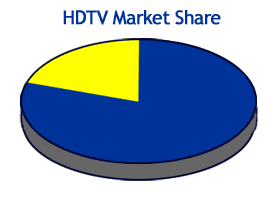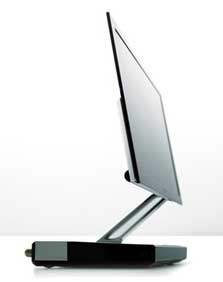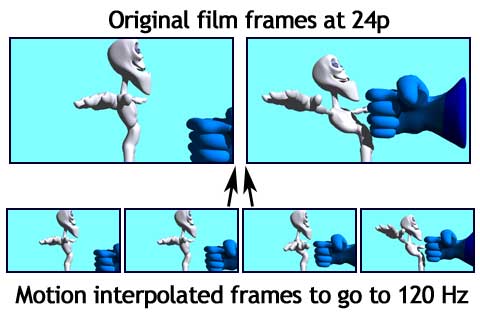
|
|
 |

|


Dick De Jong October 29, 2007 HDTV Solutions I recently attended the HDTV Conference in L.A., which featured two days full of panels of industry experts discussing topics like HD Broadcasting, (more and more HD channels are coming soon), and NextGen DVD, (Blu-ray is better; no, HD-DVD is) and Home Connectivity, (networked and wireless). The audience was full of industry suits, financial analysts and journalists who were all trying to read between the bars on those market trend graphs. Finally, during the TV Market Outlook panel, the simple question was asked, "What's the next big thing?" In monetary terms, that question becomes, What will drive consumers to buy more? In design terms, What will make our lives better? In technology terms, What's new and cool? If the current Best Buy or Circuit City ads are any indication, the simple answer would be HD. And for the general public, that is where we stand. HD is the new kid on the block.
Of course, this is an HDTV Conference in its fifth year. HD is a foregone conclusion made clear by the graphs that showed that the HD share of the U.S. TV market has doubled in the last year to 80%. For these forward looking folks even 1080p is old news, despite the fact 1080p TVs only consist of 40% of the U.S. Market. We're looking towards tomorrow, next year, and the next decade - 2010 is just around the corner. The answers from the panel varied, which might be an indication of what one person said, "There is no next big thing." He wasn't saying there was no next thing, just that it wouldn't be as big as HD or 1080p. Editor's note – Before we venture any further, I must warn you that we are entering geek territory. It's unavoidable when discussing new technologies. Let me also say that I approach these topics in a practical manner. So if you are really hoping for a lot of geek speak, you will need to head over to Wikipedia. OLED
Sony has previewed their first model, the XEL-1, which they have scheduled for release in Japan in December for a price around $1700. Before you get too excited the XEL-1 has a resolution of 960 x 540 and is only 11" across. Granted it flaunts an amazing thickness of 3mm - that's less than 1/8 of an inch. Of course, screens smaller than a foot wide don't scream home theater. Unless Sony can quickly ramp up their manufacturing capabilities, large screen OLEDs will probably fall into the next decade category. Judging from the predictions at the conference, we are still at least three or four years away from a 32" OLED display. As you can imagine, in those three or four years, plasmas and LCDs will continue to improve, robbing OLEDs of some of their luster. For example, Hitachi just announced a new line of Ultra Thin LCD HDTVs. Not paper thin, but at 1.5 inches, they are narrowing the difference, especially when you consider these will be available in 2008 in 32", 37" and 42" sizes. 3D, Lasers, and Plain Ole' LEDs The first, 3D HDTVs have already arrived. I am testing a Samsung DLP microdisplay that has the capability of projecting 3D content that can be seen with special 3D glasses. 3D is definitely not everyone's cup of tea, but it should help prolong the viability of microdisplays. Also helping revitalize that display segment is a new light engine based on lasers. The promise is brighter, sharper and truer colored images. As with every new thing, we will have to wait and see for ourselves, perhaps as soon as CES this January. The emerging light source that is having the greatest impact this year is LED. You see them appearing in microdisplays and LCDs. Some models that have begun shipping are touting Contrast Ratios from 10,000:1 to a jaw dropping, eye popping 500,000:1. Dolby, (yes, Dolby of audio fame), was demonstrating an LED system that not only increases contrast but produces a high dynamic range image from standard HD content. Their side by side comparison to a regular LCD display was startling. The expanded gray scale and deep blacks were the foundation for some stunning and sublime images. As with all of their technologies, Dolby will be licensing this one. Look for the Dolby(R) Contrast and Dolby Vision labels on TVs maybe as soon as 2008. 120 Hz The solution appearing in a number of of new LCD models is to change the frame rate to 120, which is conveniently two times 60 and five times 24. The trick is where do those extra frames come from? The best technique that I have seen is motion interpolation. With film, to go from 24 to 120 frames, you have to create four new ones in between every original one.
The video processing chips in these LCDs are slaving away comparing the two original frames and deciding which way the objects in the images are moving. From their algorithms, they create the middle four frames. The best chips interpolate both horizontal and vertical motion. If they do their jobs well, you will never notice unless you had the original footage to compare it to. And then again, if you are not bothered by judder to begin with, then 120 Hz is not the next big thing for you. Of course, if you are a frame junkie, some models are upping the ante to 240 Hz. HDMI 1.3 With the proliferation of 1080p signals, the need arose to pump more data through that pipe. The HDMI committee came out with an updated specification, 1.3, that addresses the call for increased bandwidth. Now, you are seeing all sorts of HDMI 1.3 compatible equipment.
The bigger pipe also allows for support of Deep Color and x.v.Color content that are two technologies that increase color depth and space. Will you be able to perceive the difference in a Deep Color or x.v.Color program compared to a normal HD show? In theory, probably. In practice, we will have to wait until Deep Color or x.v.Color content is available. To be clear, I am talking about three different animals here. To take HDMI 1.3 first, I see it as an evolutionary step. Basically in a year or two, all HDTVs will be 1.3 compatible. Though, by then we may be talking about 1.4. For Deep Color or x.v.Color to ever be a significant, we will need to see a lot of content being produced using these color technologies. Right now, I don't foresee that possibility in broadcast television, which still isn't planning on moving to 1080p. Content is King Luckily thanks to ESPN, TNT, TBS, and the major networks, almost all sports events are being broadcast in HD. In fact, almost all non-reality prime time programs on ABC, CBS, NBC, Fox, and the CW are HD.
And DirectTV has thrown down the 100 HD channel gauntlet. Indeed, by early next year, any self respecting content provider must offer at least 50 HD channels to compete. Then hopefully soon thereafter, you will not need to pay a premium for the HD tier. To stereotype for a second, the 50" screen attracted him and the 5" depth won her over. But Monday Night Football and HGTV in HD are what keeps them happy with their purchase. Blu-ray and HD-DVD
If there is a benefit to the format war, I believe the fierce competition has sped up the drop in prices for the units. Word is that this holiday season, we will see HD-DVDs selling below $200. And Blu-ray players that wanted to linger in the $1000 range are being pushed to at least half that price. The bottom line is that high definition DVDs are visually and audibly superior to SD DVDs. If the cost of entry keeps deflating, maybe we won't need to wait for the war to end before the format becomes a force to be reckoned with in the HD market. February 17, 2009 But the thought is that all the hubbub about the switch will cause people to think about their old TV. And for a great many, it will give them a reason to go out and buy "one of them newfangled high def'nition TVs." For others who already have an HDTV in the living room, it will be time to consider a second for the bedroom or kitchen. If the change to digital even stimulates 20% of the 175,000,000 households, it will definitely be a big thing. IPTV The real success of a marriage of the computer as media server and the living room HDTV hinges on a friendly graphical user interface between the two. If and when that is designed, then possibly HD IPTV will be a big thing. To facilitate that union, wireless networking systems that include the HDTV are becoming more and more practical. Game Systems
Halo and Gears of War rock on an HDTV. Even Wii Tennis in SD is a real aerobic workout when played on a big flat screen. What's Old is New Again
As Timbuk 3 sings, "The future's so bright, I gotta wear shades." Stay tuned. |
Bookmark:
![]() del.icio.us
del.icio.us
![]() Reddit
Reddit
![]() Google
Google
| Send this Page | Print this Page | Report Errors |











